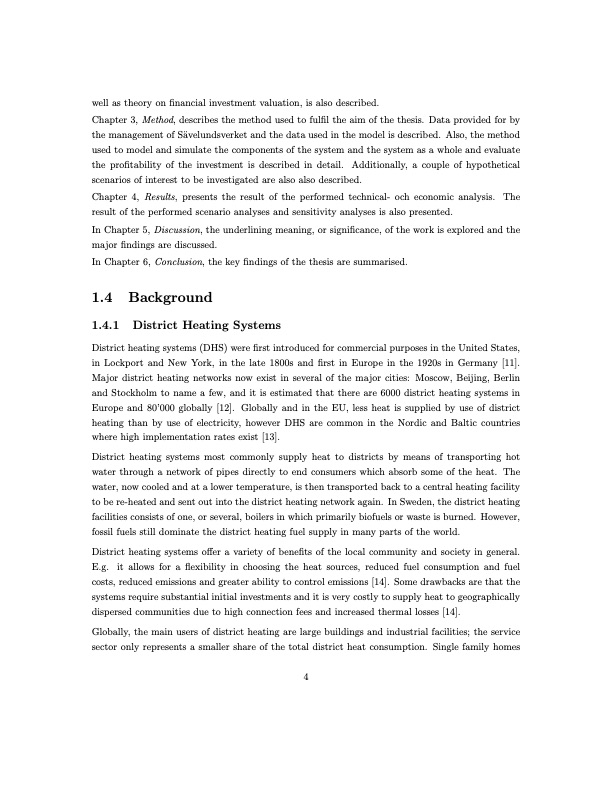
PDF Publication Title:
Text from PDF Page: 023
well as theory on financial investment valuation, is also described. Chapter 3, Method, describes the method used to fulfil the aim of the thesis. Data provided for by the management of S ̈avelundsverket and the data used in the model is described. Also, the method used to model and simulate the components of the system and the system as a whole and evaluate the profitability of the investment is described in detail. Additionally, a couple of hypothetical scenarios of interest to be investigated are also also described. Chapter 4, Results, presents the result of the performed technical- och economic analysis. The result of the performed scenario analyses and sensitivity analyses is also presented. In Chapter 5, Discussion, the underlining meaning, or significance, of the work is explored and the major findings are discussed. In Chapter 6, Conclusion, the key findings of the thesis are summarised. 1.4 Background 1.4.1 District Heating Systems District heating systems (DHS) were first introduced for commercial purposes in the United States, in Lockport and New York, in the late 1800s and first in Europe in the 1920s in Germany [11]. Major district heating networks now exist in several of the major cities: Moscow, Beijing, Berlin and Stockholm to name a few, and it is estimated that there are 6000 district heating systems in Europe and 80’000 globally [12]. Globally and in the EU, less heat is supplied by use of district heating than by use of electricity, however DHS are common in the Nordic and Baltic countries where high implementation rates exist [13]. District heating systems most commonly supply heat to districts by means of transporting hot water through a network of pipes directly to end consumers which absorb some of the heat. The water, now cooled and at a lower temperature, is then transported back to a central heating facility to be re-heated and sent out into the district heating network again. In Sweden, the district heating facilities consists of one, or several, boilers in which primarily biofuels or waste is burned. However, fossil fuels still dominate the district heating fuel supply in many parts of the world. District heating systems offer a variety of benefits of the local community and society in general. E.g. it allows for a flexibility in choosing the heat sources, reduced fuel consumption and fuel costs, reduced emissions and greater ability to control emissions [14]. Some drawbacks are that the systems require substantial initial investments and it is very costly to supply heat to geographically dispersed communities due to high connection fees and increased thermal losses [14]. Globally, the main users of district heating are large buildings and industrial facilities; the service sector only represents a smaller share of the total district heat consumption. Single family homes 4PDF Image | Analysis of Organic Rankine Cycles for a Boiler Station

PDF Search Title:
Analysis of Organic Rankine Cycles for a Boiler StationOriginal File Name Searched:
economic-analysis-orc-boiler.pdfDIY PDF Search: Google It | Yahoo | Bing
NFT (Non Fungible Token): Buy our tech, design, development or system NFT and become part of our tech NFT network... More Info
IT XR Project Redstone NFT Available for Sale: NFT for high tech turbine design with one part 3D printed counter-rotating energy turbine. Be part of the future with this NFT. Can be bought and sold but only one design NFT exists. Royalties go to the developer (Infinity) to keep enhancing design and applications... More Info
Infinity Turbine IT XR Project Redstone Design: NFT for sale... NFT for high tech turbine design with one part 3D printed counter-rotating energy turbine. Includes all rights to this turbine design, including license for Fluid Handling Block I and II for the turbine assembly and housing. The NFT includes the blueprints (cad/cam), revenue streams, and all future development of the IT XR Project Redstone... More Info
Infinity Turbine ROT Radial Outflow Turbine 24 Design and Worldwide Rights: NFT for sale... NFT for the ROT 24 energy turbine. Be part of the future with this NFT. This design can be bought and sold but only one design NFT exists. You may manufacture the unit, or get the revenues from its sale from Infinity Turbine. Royalties go to the developer (Infinity) to keep enhancing design and applications... More Info
Infinity Supercritical CO2 10 Liter Extractor Design and Worldwide Rights: The Infinity Supercritical 10L CO2 extractor is for botanical oil extraction, which is rich in terpenes and can produce shelf ready full spectrum oil. With over 5 years of development, this industry leader mature extractor machine has been sold since 2015 and is part of many profitable businesses. The process can also be used for electrowinning, e-waste recycling, and lithium battery recycling, gold mining electronic wastes, precious metals. CO2 can also be used in a reverse fuel cell with nafion to make a gas-to-liquids fuel, such as methanol, ethanol and butanol or ethylene. Supercritical CO2 has also been used for treating nafion to make it more effective catalyst. This NFT is for the purchase of worldwide rights which includes the design. More Info
NFT (Non Fungible Token): Buy our tech, design, development or system NFT and become part of our tech NFT network... More Info
Infinity Turbine Products: Special for this month, any plans are $10,000 for complete Cad/Cam blueprints. License is for one build. Try before you buy a production license. May pay by Bitcoin or other Crypto. Products Page... More Info
| CONTACT TEL: 608-238-6001 Email: greg@infinityturbine.com | RSS | AMP |